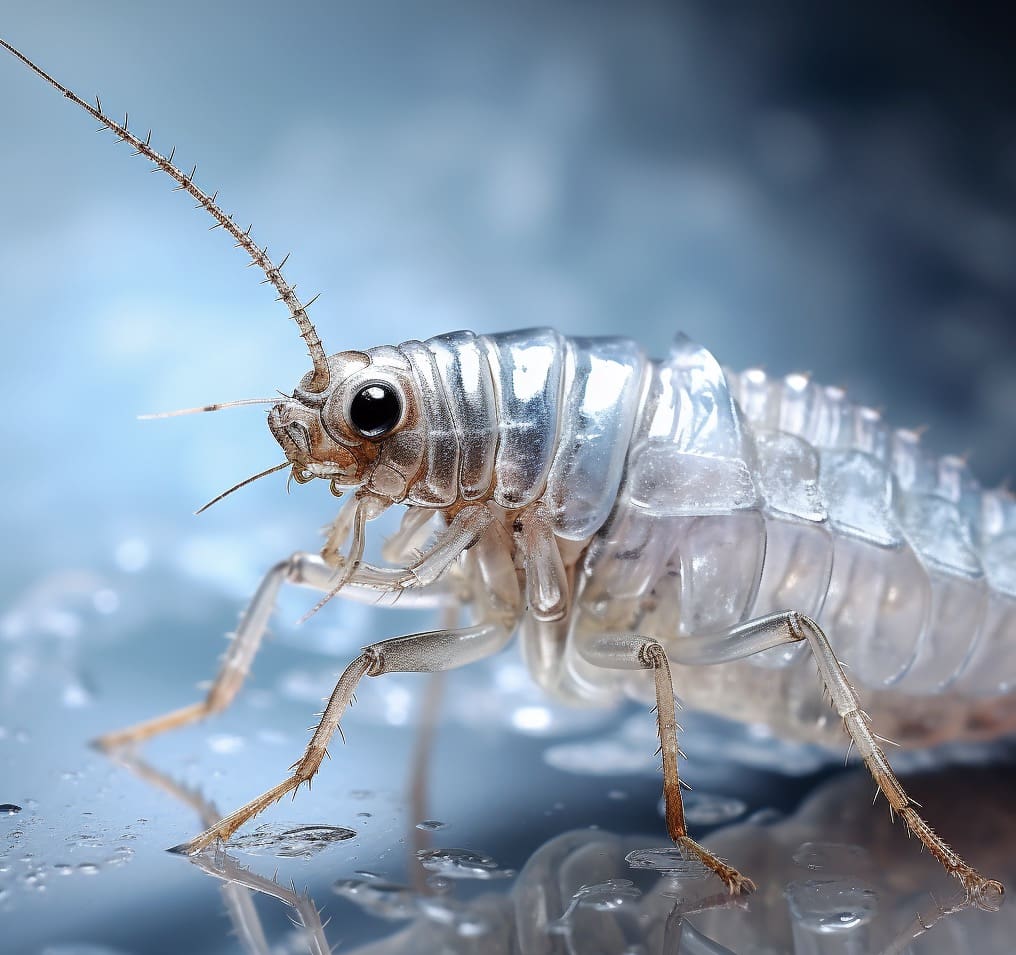
Silverfish Removal Guide
Battling silverfish in your Southern home can be frustrating. These pests are notorious for their love of humid environments and can often be found wreaking havoc indoors. They're not just creepy-crawly nuisances; they can cause real damage to your belongings.
You're not alone in your fight against these elusive insects. Silverfish infestations require professional intervention to effectively eliminate and prevent future issues. That's why understanding the importance of targeted pest control is crucial for maintaining a silverfish-free environment.
While the occasional silverfish sighting might not signal a severe problem, it's essential to stay vigilant. These pests can quickly escalate from a minor annoyance to a significant threat to your stored goods. Proactive pest management is key to protecting your home from the potential damage silverfish can inflict.
Understanding Silverfish
What Are Silverfish?
When you come across small, fast-moving insects in your home with a distinct steel grey color, you're likely looking at silverfish. These wingless pests have earned their name from their shiny appearance and brisk movements that resemble a fish swimming. At about ¾ of an inch long, they're hard to miss with their elongated, teardrop-shaped bodies and bristly features, including their well-known tail protrusions.
Characteristics of Silverfish
Silverfish are more than just a nuisance; these insects are known for their voracious appetite for starchy foods and papers. Their dietary preferences put your valuable documents, books, and even wallpaper at risk. With a carrot-shaped figure and bodies covered in silvery scales, silverfish have distinct traits which include:
- Long, flat bodies that may be mistaken for centipedes or millipedes.
- Bristly tails, earning them nicknames like Bristle Tails and Fringetails.
- They prefer dark, damp places, making areas with plumbing, like bathrooms and kitchens, hot spots for activity.
Habits and Behavior of Silverfish
Understanding the behavior of silverfish can be key in preventing and controlling infestations. These critters are nocturnal, meaning they're mostly active when you're asleep, scavenging for food in the less trafficked areas of your home. Here's what you should know about their habits:
- Silverfish navigate with their antennae and exhibit a stop-and-go motion to evade predators.
- They seek out moist, warm environments.
- Females lay eggs in secluded nooks, allowing colonies to grow undetected.
With their long lifespans and ability to survive months without food, silverfish can be persistent household pests. Their sly habits and reproduction in hidden crannies create challenges in detecting their presence early, making proactive pest control measures essential.
The Need for Silverfish Pest Control
Silverfish, though small and relatively less known, can cause significant disruption in homes across the southern United States. These pests may seem innocuous at first glance, but they can be quite destructive, and that's why controlling their population within your home is crucial. This part of the article delves into the potential damages and risks that come with silverfish infestation.
Potential Damage Caused by Silverfish
Silverfish have a notorious appetite for items containing certain materials such as paper, glue, cotton, and linen. This can translate to considerable damage to:
- Books and important documents
- Clothing and upholstered furniture
- Wallpapers due to their fondness for the paste
The damage is not always immediate but can become apparent over time as they continue to feed and multiply. Statistics show that a single female can lay up to 60 eggs at a time, meaning that silverfish populations have the potential to expand rapidly, posing a more significant threat to your possessions. The following table breaks down the reproduction potential of silverfish, highlighting how quickly they can become a problem:
| Life Stage | Egg Count | Development Time |
|---|---|---|
| Egg | Up to 60 | 2 weeks - 2 months |
| Adult | --- | Can live 2-8 years |
Given these figures, it's easy to see why prompt action is necessary to prevent silverfish from claiming dominion over your valuable belongings.
Risks Associated with Silverfish Infestation
While silverfish are not directly harmful to humans, as they don't bite or spread diseases, they pose indirect health risks. These include:
- Triggering allergic reactions
- Potential to spread harmful bacteria
Moreover, the presence of silverfish can attract other pests such as spiders, earwigs, centipedes, and carpet beetles, all of which come with their own sets of problems. These secondary infestations can compound the issues within your home, turning a small nuisance into a larger pest control problem.
Managing moisture levels in your home, sealing entry points, and being proactive in identifying and addressing any signs of silverfish can help minimize these risks. Remember, while silverfish may not pose the same overt threats as some pests, underestimating them can lead to unnecessary damage and additional pest-related issues in the long run.
Preventive Measures for Silverfish Control
Keeping the Home Clean and Dry
In your battle against silverfish, maintaining a clean and dry home environment is paramount. Regularly vacuum your abode, focusing on carpets and upholstery where silverfish might find refuge. Ensure that you're not providing these pests a hospitable environment by promptly cleaning spills and limiting open food sources. Utilizing air conditioning and dehumidifiers can drastically reduce humidity, making your interiors less inviting to these humidity-loving insects.
Addressing Moisture Issues
A key step in deterring silverfish is to address any moisture issues in your home. Fix leaky pipes, and repair dripping faucets immediately—silverfish depend on these moisture sources to survive. If you reside in a region known for high humidity, such as Florida, employing air conditioners and dehumidifiers can effectively make your home less appealing. Remember that humidity levels between 75-95 percent are like a siren's call to silverfish, so aim to keep indoor humidity under control.
Reducing Clutter and Removing Food Sources
To make your home less attractive to silverfish, reduce clutter. Old books, papers, and clothes can provide hiding spots for these pests, so tidying up is a form of pest control that's often overlooked. Store dry goods, including cereal and flour, in airtight containers to cut off their access to food. Without their preferred food, silverfish will seek other quarters, potentially leaving your home behind. Also, opting for plastic storage bins instead of cardboard boxes for long-term storage can also help, as both silverfish and roaches are known to favor the corrugation in cardboard.
Sealing Entry Points
Finally, don't forget to seal up potential entry points around your home. Check for and caulk cracks around windows, doors, and baseboards. Install covers on vents and inspect your house's foundation and siding for openings where silverfish might slip in. By sealing these areas, you're cutting off easy access to your living spaces, providing one more layer of defense against a potential silverfish infestation. Keep a close eye on exterior maintenance as well, including clear gutters and proper landscaping to prevent dampness near the structure of your home.
DIY Silverfish Control Methods
Natural Remedies for Silverfish Control
You're on a mission to tackle silverfish in a more eco-friendly way, and there are several natural remedies you can employ. Cedar oil and diatomaceous earth are among the popular choices for their repelling properties, but their effectiveness varies and is often debated. Using natural desiccants like boric acid not only helps in repelling these pests but also causes them to perish due to dehydration. It's important to understand that while these substances are labeled 'natural', they must still be used cautiously to ensure safety, especially in homes with children and pets.
- Cedar oil: Apply in areas where silverfish are frequently spotted.
- Diatomaceous earth: Sprinkle in cracks and crevices, near baseboards, or in cabinets.
- Boric acid: Lightly dust in hard-to-reach areas where silverfish could hide.
Strategically place bay leaves in areas that silverfish frequent. Though not scientifically proven, there is anecdotal evidence that the herb might work as a deterrent due to its strong scent.
Using Traps to Catch Silverfish
Implementing traps is a practical and less invasive method to manage silverfish infestation. Sticky traps are incredibly straightforward—peel and place them in areas where silverfish are present or suspected. These spots typically include dark and damp locations such as under sinks, in pantries, or near bookcases. Roll up a newspaper as a homemade trap; silverfish may find it irresistible and crawl inside. Here's a simple breakdown for setting up your traps:
- Newspaper: Roll and moisten it slightly to attract silverfish for a temporary home.
- Homemade sticky traps: Use a thick layer of glue on cardboard.
- Store-bought sticky traps: Convenient and ready to use.
Monitor and replace traps regularly to keep tabs on the infestation levels, and always dispose of used traps promptly to help maintain a clean environment.
Applying Insecticides
For those who prefer a more aggressive approach, using insecticides might be the route you take. You can find suitable residual pesticides and apply them with care around the perimeter of your home to keep silverfish at bay. Additionally, spot treatments in targeted areas indoors can swiftly reduce silverfish populations. It's vital that you follow all safety instructions and consider the impact of insecticides on your home environment.
- Local spot treatment: Ideal for immediate control in specific areas.
- Perimeter spray: Deters silverfish from entering your home.
Remember, these methods can be effective, but they come with a level of risk, especially if not applied properly. Always prioritize your safety and the well-being of your household when using chemical insecticides.
Professional Silverfish Control Services
Advantages of Hiring Professionals
When silverfish infest your space, turning to professional pest control services offers significant advantages. Experts possess extensive knowledge about silverfish habits and their hidden nesting places, which enables them to tackle infestations more effectively than DIY methods ever could. They're equipped with the right tools and expertise to assess and address the problem, ensuring a thorough job. Professional services also save you time and potential frustration – imagine trying to eradicate silverfish without knowing their intricate behaviors or the safety protocols for chemical use.
Speed is another crucial factor. With their experience, professionals can swiftly identify the severity of your infestation and apply immediate solutions, preventing further damage to your property and belongings. Moreover, they can provide a satisfaction guarantee; if you're not happy with the results, they're committed to making it right. This peace of mind is priceless, especially when dealing with a persistent pest like silverfish.
Methods Used by Professionals
Professional pest controllers employ a variety of methods to ensure silverfish eradication. After a thorough inspection, they may utilize bait, traps, habitat modification, and repellents. In some cases, chemical treatments may be necessary, but rest assured that professionals follow stringent safety guidelines to protect you and your environment.
Professionals know the importance of Integrated Pest Management (IPM), combining various treatment methods tailored to your specific situation. These may include sealing cracks to prevent entry, using dehumidifiers to reduce moisture, and strategically placing insecticide in areas of high silverfish activity. They also understand the necessity of follow-up visits to prevent re-infestation, offering various service intervals ranging from monthly to bi-annual treatments, based on your needs and preferences.
Choosing the Right Pest Control Company
Selecting a pest control company that matches your needs requires careful consideration. Look for those with experienced technicians who are well-versed in dealing with silverfish. It's essential that they conduct comprehensive inspections – from basement to attic – and communicate clearly about their findings and the expected outcomes of their treatment plan.
A company's reputation for effectiveness, efficiency, and customer satisfaction is paramount. You'll want a team that doesn't just rely on chemical products but also incorporates preventive measures. Verify that the service you choose offers flexibility in scheduling and a service guarantee. With the right partner, your battle against silverfish will be backed by the full force of professional expertise and dedication.
Conclusion
Tackling silverfish in your home doesn't have to be a losing battle. With the right approach and professional help, you can reclaim your space from these pesky intruders. Remember that early detection and integrated pest management are key to keeping silverfish at bay. Trust in the expertise of professionals to provide effective solutions tailored to your situation. Choosing a reputable pest control company will ensure that your southern home remains free from silverfish and the damages they cause. Stay vigilant and proactive, and you'll enjoy a pest-free environment year-round.
Frequently Asked Questions
What scent keeps silverfish away?
Silverfish are naturally repelled by certain scents including cedar, citrus such as orange and lemon, as well as peppermint, rosemary, bay leaves, clove, cinnamon, and lavender. Utilizing these scents, particularly in the form of essential oils, can deter silverfish from frequenting areas of concern.
How do I get rid of silverfish permanently?
Permanent removal of silverfish can be achieved through a combination of methods: sealing food in containers, using tape on the outside of glass jars as traps, rolling up damp newspapers as bait, employing sticky traps, spreading silverfish poison in infested areas, and using the natural repellent properties of cedar wood or cedar oil. Placing dried bay leaves in key areas can also help.
How much is pest control for silverfish?
The cost for professional silverfish pest control can vary, but services may start from around $120 plus VAT. Prices depend on the severity of the infestation, the size of the property, and the specific treatment plan needed to effectively control the silverfish population.
Can silverfish get in your bed?
Yes, silverfish can find their way into beds, although they generally prefer humid areas like bathrooms and closets. Known for their silver, teardrop-shaped bodies and lengthy antennae, these pests are primarily a nuisance rather than harmful, but they can cause damage to bedding materials.
Do you need to call pest control for silverfish?
For small-scale infestations, you may attempt to handle silverfish on your own. However, for comprehensive and effective elimination, especially in the case of large infestations, professional pest control is recommended. Experts like Romex Pest Control can treat both adult silverfish and their hiding places, helping to ensure that the pests do not return.
We hope you enjoy these informational articles. If you'd like to learn more about our eco-friendly pest control services, call (844) 955-2447.
Read More
Your Path to a Pest-Free Home or Business
Romex Pest Control
We are committed to protecting you, your children, and your pets with our eco-friendly, child-friendly, and pet-friendly guaranteed pest control solutions.
Romex Pest Control is fully insured and licensed in Texas, Oklahoma, Louisiana, and Mississippi.
Hours
M-F 8 am–5 pm
Sat 8 am–2 pm
Sun Closed
Established 2016 © Copyright 2025 Romex Pest Control










